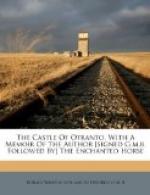|
This section contains 6,312 words (approx. 22 pages at 300 words per page) |

|
SOURCE: "Time and Family in the Gothic Novel: The Castle of Otranto." Eighteenth Century Life, Vol X, n.s. 3, October, 1986, pp. 159-71.
In this essay, Watt contends that the elements of the "imaginative matrices" of The Castle of Otranto that particularly structure the Gothic tradition are Walpole's treatment of time and the family.
Long ago Matthew Arnold, confronting what Darwin had recently demonstrated to be our common ancestor—"a hairy quadruped furnished with a tail and pointed ears, probably arboreal in his habits"—was moved to wonder how "this good fellow" could ever have "carried in his nature, also, a necessity for Greek."1 It was even longer ago that an unpromising stripling named Conrad was dashed to pieces by some archaic military hardware in the courtyard of the Castle of Otranto; and even today we still hardly know how it was that this "enormous helmet, a hundred times...
|
This section contains 6,312 words (approx. 22 pages at 300 words per page) |

|


